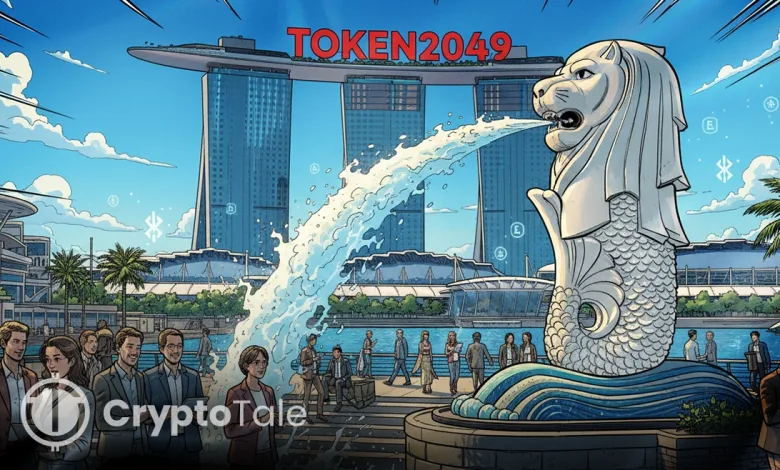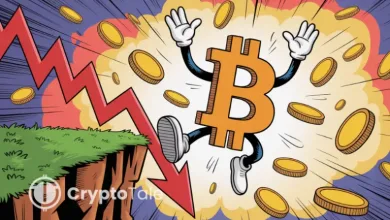Insights For Readers From TOKEN2049: Key Trends in Stablecoins, DeAI, and ZK

- Stablecoins power Web3 adoption, modernizing payments, trading, and global digital finance.
- TOKEN2049 Singapore highlights tokenization as stocks, gold, and RWAs go on-chain.
- DeAI and ZK proofs are defining the blockchain’s future, merging privacy, compliance, and scale.
TOKEN2049 Singapore (October 1–2, 2025) reinforced its reputation as one of the most influential gatherings in the crypto industry. Following the attention on TOKEN2049 Dubai earlier this year, the Singapore edition highlighted Asia’s central role in the growth of Web3.
The event attracted more than 25,000 attendees from 160 countries, with over 500 exhibitors and 300 speakers. Beyond its scale, TOKEN2049 provided a stage for critical announcements on tokenization, stablecoins, decentralized artificial intelligence (DeAI), and zero-knowledge privacy technologies.
The conference also generated over $1 billion in economic activity for Singapore, underscoring the city-state’s growing significance as a global crypto hub.
Justin Sun Launches SunPerp After Crypto Roast at TOKEN2049
TRON DAO served as the title sponsor of TOKEN2049 Singapore. Founder Justin Sun took part in the inaugural “Crypto Roast,” a lighthearted segment that drew a large audience. He later delivered a keynote announcing SunPerp, TRON’s decentralized perpetual trading platform.
Alongside the keynote, TRON hosted a networking lounge and a major community event. The sponsorship emphasized TRON’s stablecoin flows, ecosystem growth, and its role in connecting developer discussions with broader community engagement.
Stablecoins at the Center of Adoption
Stablecoins emerged as a key subject at TOKEN2049. During the event, Coinbase’s Base announced its forthcoming support for Singapore dollar and Australian dollar stablecoins, expanding upon its existing support for currencies from emerging markets. Jesse Pollak, Head of Base, underscored the importance of non-USD stablecoins in facilitating real-world applications.
Donald Trump Jr. encouraged the development of the USD1 stablecoin, which can be paired with tokenized commodities such as oil, gas, and cotton. He likened the efforts faced by crypto companies to the hurdles they encounter in debanking, comparing them to those experienced by traditional institutions. He described this as an obstacle now being removed by regulatory clarity.
MEXC Ventures has added $66 million to Ethena’s USDe and ENA stablecoins, fortifying its belief in stablecoins. At the same time, Circle’s Heath Tarbert outlined how stablecoins currently operate as both compliant and programmable financial tools.
This growth suggests that stablecoins are no longer experimental in the financial sector. They are rapidly emerging as the foundational infrastructure for global payments, trading, and investment activities.
Stablecoins Break $300 Billion Market Cap
Furthermore, stablecoins hit a historic milestone during the TOKEN2049 week. DefiLlama data indicates that on October 3, 2025, the total market cap of stablecoins exceeded $300 billion, a 47% increase since the start of the year. The rise positions the market for wider access amid a surge in new issues and applications.
Tether (USDT) and Circle’s USDC continue to hold the largest market share among stablecoins. Still, the yield-bearing stablecoin Ethena’s USDe became the fastest-growing, with its supply rising from $6 billion in January to nearly $15 billion by October.
Analysts said the $300 billion milestone is more than symbolic. Industry leaders described it as a sign of maturity, and stablecoins are expected to reach $500 billion before achieving mainstream adoption and $1 trillion by the end of the decade.
Related: Are Stablecoins Reshaping Global Monetary Policy
The Next Frontier: Tokenization and Real World Assets
Tokenization gained heavy interest as a viable step between traditional assets and blockchain. Robinhood CEO Vlad Tenev dubbed tokenization “an unstoppable freight train,” and said it’s “inevitable that all equities, commodities, and even real estate will trade on-chain in the future.”
He later posted on social media: “PSA: Tokenization will eat finance,” reinforcing his belief that traditional markets cannot resist tokenization. Moreover, Robinhood has already introduced tokenized equities in Europe, featuring assets such as SpaceX shares, and is expanding its offerings.
Announcements set a brisk pace from the opening moments. Alpaca launched its Instant Tokenization Network (ITN) to mint and redeem tokenized U.S. stocks 24/7. The platform aims to support in-kind settlement and reduce friction across brokers and market makers.
Meanwhile, a notable theme was the tokenization of real-world assets. Celo’s launch of XAUt0 has provided access to tokenized gold across its ecosystem, and GEMtrust’s DiCom has introduced gem-backed tokens as an alternative asset class. xBrokers, the liquidity hub for tokenized RWAs, was also expanded by Ju.com.
Artificial Intelligence and DeAI
Artificial intelligence was not just a topic of discussion, but at the center of product announcements. Kava Labs leveraged the BNB Chain with the release of kava AI, offering users AI-enabled portfolio management, yield optimization, and cross-chain capabilities.
AI and blockchain can be combined in real-world applications, as demonstrated by Robo.ai’s Roboy339, which enables vehicles to handle payments among themselves. Conference panels also examined decentralized AI (DeAI) models, emphasizing the importance of deploying AI on blockchain for transparency and protection against censorship.
These developments suggest that AI will become an integral part of Web3 infrastructure, and decentralized deployment will ensure that financial applications remain verifiable and accessible.
Zero-Knowledge Proofs and Privacy
Privacy technologies took a big leap forward at TOKEN2049. Celo’s launch of EY Nightfall is the first instance where a zero-knowledge privacy layer is deployed for enterprise transactions in a payments-focused blockchain. Nightfall enables B2B transactions that are both confidential and auditable, meeting compliance requirements while also ensuring privacy.
At TOKEN2049, several speakers stressed that zero-knowledge proofs (ZKPs) are becoming essential for enterprise blockchain adoption. ZKPs let organizations prove the accuracy of data without revealing the data itself.
This capability is critical in industries where privacy, compliance, and transparency must coexist. By allowing sensitive transactions to remain private while still meeting audit and reporting requirements, ZKPs provide enterprises with both security and accountability. The focus on ZKPs signals a strategic shift toward scalable, privacy-first infrastructure.
Regulatory Leadership
Indonesia’s Crypto Asset Futures Exchange highlighted the strategic framework behind the country’s growing crypto market. With more than 16.5 million registered users as of July 2025, and a three-pillar solution (exchange, clearinghouse, and custodian), CFX illustrated how Southeast Asia is developing regulatory frameworks.
Indonesia emerged as a regulatory leader, climbing from 20th place in global crypto adoption rankings in 2022 to 7th in 2025. Its Crypto Asset Futures Exchange highlighted a regulated three-pillar structure, which has already boosted domestic crypto adoption by 25% this year. This model demonstrated how collaborative regulation can encourage innovation while protecting investors.
“Within this trusted framework, Indonesia is ready to serve the next wave of crypto products, which will include stablecoins, tokenized Real-World Assets (RWA), and crypto financing,” Jeth Soetoyo, the CEO, added.
At the same time, sovereign engagement is on the rise. The approach to crypto reserves in Kazakhstan and the growth of digital investments in corporate treasuries were indications that governments and institutions are integrating crypto into their long-term plans.
Related: Cryptocurrency Regulation in Asia: 2025 Policies Overview
OKX Roadmap and Developer Incentives
OKX founder Star Xu revealed a three-phase roadmap for the X Layer network. The plan includes:
- Launch of the USDG stablecoin
- Integration of leading DeFi protocols such as Aave and Uniswap
- A $100 million developer fund to support projects in DeFi and memecoins
The roadmap targeted liquidity, safety, and composability. It signaled OKX’s ambition to build an ecosystem that attracts both retail and institutional developers.
Pi Network’s Testnet Rollout
Pi Network co-founder Dr. Chengdiao Fan announced new blockchain features that have been deployed first on the testnet. These tools aim to support payments and identity use cases, with mainnet access scheduled after testing.
The project also concluded a “.pi” domain auction, generating over 200,000 bids and millions of Pi tokens in value. These developments reinforce Pi’s strategy to move beyond speculation and toward practical Web3 applications.
Conclusion: The Way to a Hybrid Financial Future
Speakers at TOKEN2049 Singapore 2025 highlighted that the digital asset industry is no longer evolving independently of traditional finance. Instead, they are merging into a hybrid system. Institutional flows have reached record levels. Sovereign entities are taking direct action. Financial infrastructure is being tokenized, and stablecoins are becoming more integrated. The use of AI and zero-knowledge proofs is setting the stage for innovation that will meet compliance and utility needs.
This event demonstrated that crypto is not concerned with replacing traditional finance, but instead with integrating with it. Traditional finance adds governance, compliance, and scale, while decentralized finance introduces programmability, speed, and innovation. Together, they are creating a global financial system centered on verifiable trust.
TOKEN2049 was more than the announcements to investors, developers, and institutions. It provided a roadmap toward a programmable, transparent, and global future of finance.





